Most of the diesel bus fleet in New Zealand is comprised of 10.0m to 13.5m single deck buses and includes two to three axle vehicles as described in Bus Dimensions for Design.
PTDG: Bus dimensions for design
Three axle diesel double deck buses are used in Auckland, Hamilton, and Wellington on high demand routes. The diesel buses used in New Zealand have capacity for 30 to 110 passengers and have a range of approximately 800km depending on fuel tank size and expected loading weight, though the RUB only requires a range of greater than 350km or 15 hours of operation. There are also select routes in Auckland that use articulated buses and they are being considered for other routes in both Auckland and Wellington. The Public Transport Design Guidance will provide additional guidance related to articulated buses in the future.
Currently, the most common type of battery electric bus is a 12m single deck bus with two axles, which typically have a 50 to 60 passenger capacity (including standing). The Requirement for Urban Buses in New Zealand (RUB) specifies that a battery electric bus range must be able to meet operational requirements without the need for an additional bus. This is a transitional measure while technology is advancing at a considerable pace and may be revisited. Expected battery degradation should be considered in calculating the service life of an electric bus, as typically a battery loses 30% capacity after 8 years of operation. However, improvements in battery chemistry and battery management systems are extending the service life of batteries.
Requirements for Urban Buses in New Zealand (RUB)
Since 2021, larger battery electric buses with three axles have been operating in Auckland and Wellington. The battery electric bus market is evolving with electric double deck and articulated buses becoming available from manufacturers. Exemptions may be granted to the Vehicle Dimensions and Mass Rule (VDAM) requirements to support heavier buses depending on the strength of the road surface and the weight limit of any bridges along the route. It is recommended that an assessment of pavement and bridge condition is completed in advance of purchasing any buses which required a VDAM weight limit exemption.
Land Transport Rule: Vehicle Dimensions and Mass (VDAM) 2016
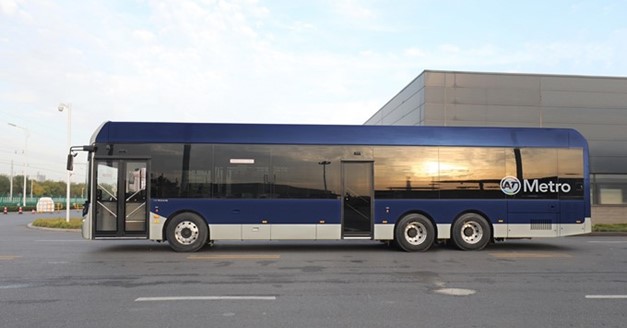
Three axle battery electric bus used in Auckland. (Source: Auckland Transport)
The RUB requires future battery electric buses purchased in New Zealand to have at least one CCS2 charging port. The location of charging ports on buses needs careful consideration with public transport contracting authorities to ensure consistency in depot layout and interoperability of buses around New Zealand. Consistent placement of the charging port on the left-hand side of the bus rearward of the rear axle is very strongly recommended (note that this recommendation applies to pantograph-charged buses too). A second plug on the right-hand side of the bus is optional but also recommended to support charging flexibility. Some operators might wish to have multiple plugs in these locations to accommodate different types of charging (eg slow and fast charging).
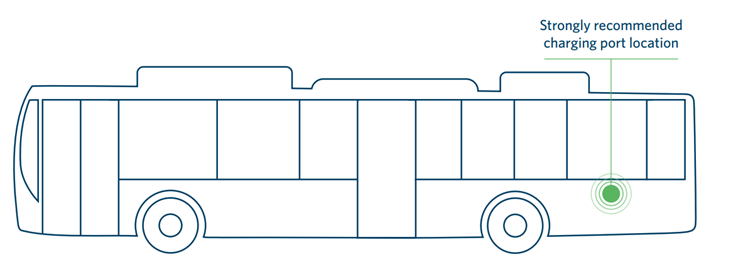
Recommended location of charging port is on the left side of the bus behind the back axle.
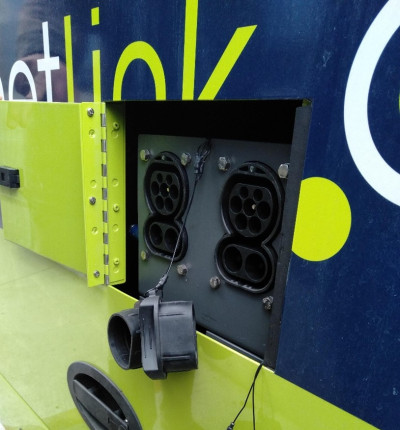
A bus with multiple charging ports. (Photo: Kirsten Boardman)
To support a safe system, locating charging points on the rear (back) or front of the bus is discouraged. This is due to risks of bus roll-away or necessitating the driver to step into the road corridor to plug in if at a road-side charger.
Consider the placement of any charging pedestals in relation to the bus charging port location as this can affect:
While you need to ensure charging cables are long enough to be safe and convenient (see image below), we also recommend keeping charging cables as short as practicable to keep the cable weights low enough to support a healthy and safe working environment for staff.
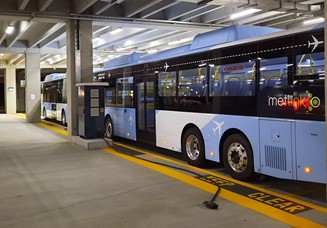
At Wellington Airport Metlink have established capacity to charge two buses at a time by positioning a pedestal charger between two bus parking spaces and providing two relatively long cords. (Photo: Edward Wright)
It is acknowledged that in some instances longer cables many be required, in which case they can be accommodated by support structures (see image below).
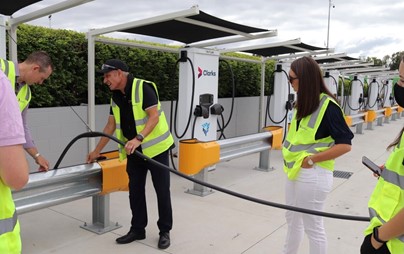
A support structure for the charging cable. (Photo: Meaghan Scanlon/Linkedin)